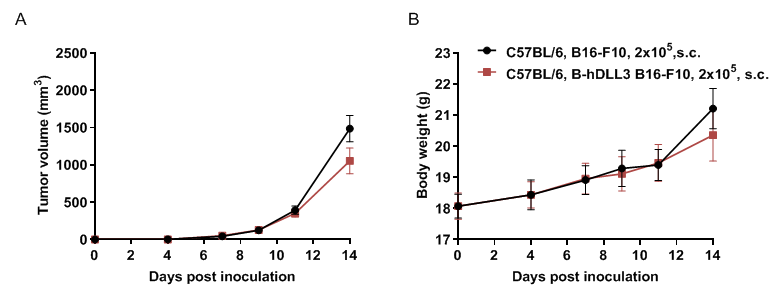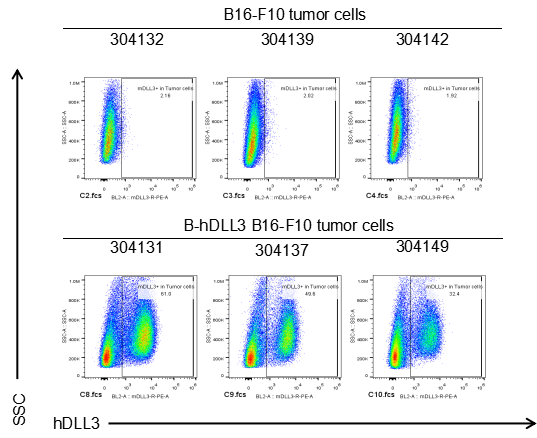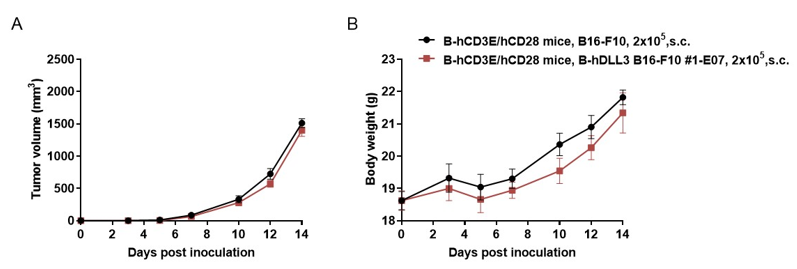B-hDLL3 B16-F10
|
Common name |
B-hDLL3 B16-F10 | Catalog number | 321826 |
| Aliases | DLL3, SCDO1, delta like canonical Notch ligand 3 | Disease | Melanoma |
|
Organism |
Mouse |
Strain | C57BL/6 |
| Tissue types | Skin | Tissue | Skin |
Gene targeting strategy for B-hDLL3 B16-F10 cells. The exogenous promoter and chimeric human DLL3 coding sequence was inserted to replace part of murine exon 2 and all of exons 3-5. The insertion disrupts the endogenous murine Dll3 gene, resulting in a non-functional transcript.

DLL3 expression analysis in B-hDLL3 B16-F10 cells by flow cytometry. Single cell suspensions from wild-type B16-F10 and B-hDLL3 B16-F10 cultures were stained with anti-DLL3 antibody. The mouse antibody is cross-reactive between human and mouse. Human DLL3 was detected on the surface of B-hDLL3 B16-F10 cells but not wild-type B16-F10 cells. The 1-E07 clone of B-hDLL3 B16-F10 cells was used for in vivo tumor growth assays.

Subcutaneous homograft tumor growth of B-hDLL3 B16-F10 cells. B-hDLL3 B16-F10 cells (2x105) and wild-type B16-F10 cells (2x105) were subcutaneously implanted into C57BL/6 mice (female, 7-week-old, n=8). Tumor volume and body weight were measured three times a week. (A) Average tumor volume ± SEM. (B) Body weight (Mean ± SEM). Volume was expressed in mm3 using the formula: V=0.5 X long diameter X short diameter2. As shown in panel A, B-hDLL3 B16-F10 cells were able to form tumors in vivo and can be used for efficacy studies.

B-hDLL3 B16-F10 cells were subcutaneously transplanted into C57BL/6 mice (n=8), and on 18 days post inoculation, tumor cells were harvested and assessed for human DLL3 expression by flow cytometry using anti-mouse DLL3 antibody that is cross-reactive between human and mouse. As shown, human DLL3 was highly expressed on the surface of tumor cells. Therefore, B-hDLL3 B16-F10 cells can be used for in vivo efficacy studies of DLL3 therapeutics.
Tumor growth curve & Body weight changes

Subcutaneous homograft tumor growth of B-hDLL3 B16-F10 cells. B-hDLL3 B16-F10 cells (2x105) and wild-type B16-F10 cells (2x105) were subcutaneously implanted into B-hCD3E/hCD28 mice (female, 7-week-old, n=5). Tumor volume and body weight were measured three times a week. (A) Average tumor volume ± SEM. (B) Body weight (Mean ± SEM). Volume was expressed in mm3 using the formula: V=0.5 X long diameter X short diameter2. As shown in panel A, B-hDLL3 B16-F10 cells were able to form tumors in vivo and can be used for efficacy studies.











